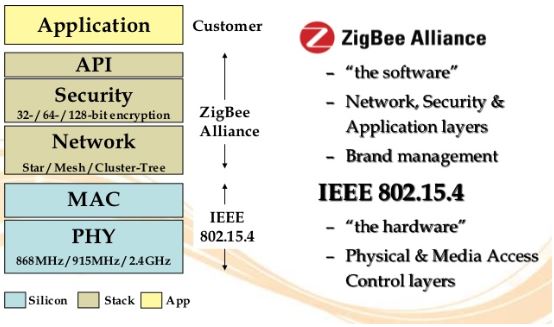Zigbee is a wireless technology based on IEEE 802.15.4 standard which very well suits the unique needs of low cost, low power wireless IoT networks. It was created by the ZigBee Alliance which comprises of technology partners like Philips, Motorola, Intel and HP. It operates in the unlicensed band including 2.4 GHz, 900 MHz and 868 MHz.
It is most widely employed for sensors and control devices which are based on low cost connectivity. Unlike Wi-Fi and Bluetooth, ZigBee supports low data rates and can fit into a tiny stack. It is designed to control simple devices like LEDs or home appliances which can be controlled by a single unit. However, it’s widespread use is found in Wireless Sensor Networks or WSN. WSN is a network of wireless sensors that can collect and store the surrounding data and transfer them to a central network or to a nearby gateway. This technology basically targets battery-operated devices which need supports low power modes.
ZigBee Architecture
ZigBee architecture is often referred to as stack. The following figure explains about the ZigBee Layered architecture.

The lower two layers i.e. the Physical layer and the Media Access Layer are defined by the IEEE 802.15.4 while the upper layers i.e. the Network Layer and the frameworks of Application Layer.
The Application Layer extends its functionality to support Application Support (APS) sub-layer, ZigBee Device Objects (ZDO) and the application object for manufacturers. The entire sub-layers of Application layer are controlled by the Zigbee Alliance. In between the ZigBee layers of the stack are the Service Access Points (SAPs) which provides isolation of the working of different layers.
The PHY layer is responsible for translating the data packets for transmission and then do the reverse at the reception.
The MAC layer provides an interface between the physical and the Network layer. This layer is responsible for providing PAN ID and also network discovery upon requests.
The Network layer in turn acts as an interface between the MAC and the Application layer. It uses mesh networking to connect the devices. It is also responsible for encrypting the data and providing a secure transmission.
The Application layer is the user interface layer and consists of the APS and the ZDO. The APS is responsible for discovery and binding services. The ZDO manages the over the air management of the network.
ZigBee Devices
There are two types of ZigBee Devices – FFD or Full Function Devices and RFD or Reduced function Devices.
FFD Devices can perform all the functions of the network and can take up any role. Whereas, RFD has limited capabilities.
An FFD device must always be active and listening to the network whereas an RFD device can only talk to an FFD device.
Both the FFD and the RFD devices can take up three roles namely – Coordinator, PAN Coordinator and Device. The Coordinator and the PAN Coordinator are taken up by the FFD devices while the Device can be anything. The main controller of the network in the Personal Area network or PAN is the PAN Coordinator and the Coordinator simply broadcasts or relays messages in the network.
The Device is just a node or a point in the network. The ZigBee standard supports three protocol devices
- ZigBee Coordinator
- ZigBee Router
- ZigBee End Device
ZigBee Protocol topologies
ZigBee supports star, Cluster Tree and mesh topologies.
In the Star topology there is only one Coordinator and any number of end nodes or devices where all the end devices are connected to the Coordinator. The end devices can communicate only via the coordinator and cannot communicate with each other directly.
The cluster tree is the peer-to-peer topology where the end devices join the network via Coordinator or the Router. The Router extends the range of the network and hence the end devices may need not be in the direct contact of the Coordinator.
The Mesh topology is also a peer-to-peer topology but it is an extension of the Cluster tree topology. The end devices that are FFD devices can directly talk to other FFD devices whereas the RFD devices need to communicate with the Coordinator or the Router.
Due to its low cost and high efficiency, it is used in many applications like home automation, Consumer electronics, Industrial automation, healthcare, etc.
Author
Anupama kumari
M.Tech (VLSI Design and Embedded system)
BS Abdur Rahman University
